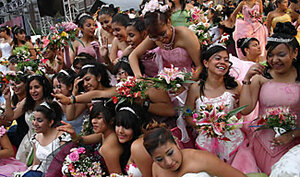Quinceañera costs rising, Mexico City hosts a free party
Some 300 girls shared in one rite-of-passage party Saturday, which donors made possible.

Big day: Some 300 girls reveled in a mass quinceañera Saturday in Mexico City. Donors made possible the rite-of-passage party which, like weddings in the US, have become pricey affairs.
Asel Llana Ugalde / Special to The Christian Science Monitor
Mexico City
Nearly 300 of them stood in Mexico City's Zocalo, or central plaza, dressed in the most expensive dresses they'd ever worn – gowns of yellow and white, some with stitched pink flowers and white lace trim. They wore tiaras in their hair and giggled nervously.
Like teenage girls throughout Mexico, this night – the celebration to mark their 15th birthdays and that once signaled the step to marriage and motherhood, called the quinceañera – is the party they dream about throughout their childhood, and the event talked about in school hallways all year.
But too many Mexicans – like the 300-some here Saturday night – can't afford the rite of passage that, like weddings in the United States, has become a multimillion-dollar industry, with planners choosing everything from invitations to bands and dresses alone costing hundreds of dollars. So in 2007 Mexico City had an idea: a mass quinceañera, which became the world's largest on record. This year the number of participants nearly doubled.
"We are not only rescuing a grand tradition in the Mexican family," says Javier Hidalgo, director of Mexico City's Youth Institute, from the roof of his organization as a dozen girls practice the waltz, a central feature of quinceañeras, days before the event. "We are emphasizing equity."
The mass dance for disadvantaged girls comes amid a campaign to improve the quality of life in one of the world's biggest, most crime-ridden, and most congested cities. This year left-leaning Mayor Marcelo Ebrard introduced women-only busses; last year it was "beaches" in public parks. This winter the city turned the Zocalo into an ice rink.
But the impetus for a public quinceañera came from the girls themselves. Last year, while discussing teen rights to education, culture, and recreation at a Youth Institute program, one teenager asked: Then why don't we have the right to a quinceañera?
"In school, people talk about their quinceañeras, and show off the dress they are going to wear, and you think, hmmm, I want that," says Alejandra Contreras, who was 17 when she finally experienced her coming-out party last year with the city.
So they sought support from the institute and took their idea to parents, friends, store owners, teachers, and local politicians.
Alejandra's friend Cristina Moreno, who is about to enter high school, says all the money her father makes as a part-time taxi driver goes to food and utilities. As the only daughter with six brothers, she never dreamed of asking her family to throw her a party.
But last year, when she stepped out of her father's green Beatle taxi in a lacy white dress, camera shutters in her face, she says she felt like a princess for the night: "It was magical."
In a culture where the notion of charity is not a strong undercurrent, says Mr. Hidalgo, this event is unique in that it is paid for entirely by donations; the city doesn't budget for it. This year, volunteers came to help tailor dresses, teach waltz steps, and apply mascara and eye shadow. In lieu of traditional carriages, red, double-decker tour buses transported girls from the Youth Institute to the Zocalo.
Some 200 dresses, which cost at least $150 each in a country where the minimum wage is under $5 a day, were donated by a group of store owners who specialize in the quinceañera. Some were even donated by legislators.
"This is a way to give a little help to girls with few resources," says Sergio Ramirez, who sells dresses at his store, Palace of the Quinceañera. His dresses cost an average of $400. This year he donated 12.
The girls beamed in them. In a bright yellow, strapless dress, Elisa Berenise says she never expected so many people to come out and see them dance the waltz, as she looks at the giant screen televisions showing those farther back in the crowd. "I feel so happy," she says. "I can't believe it."
